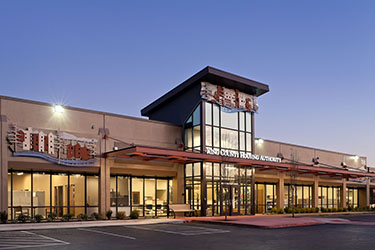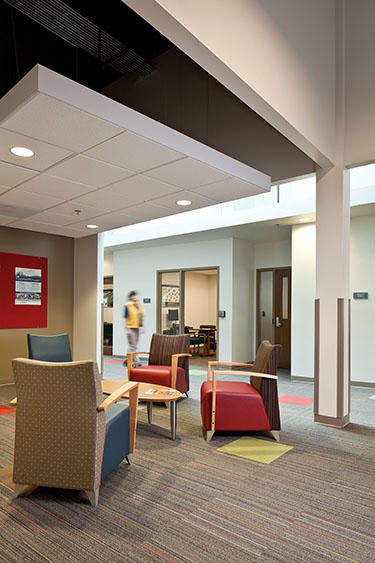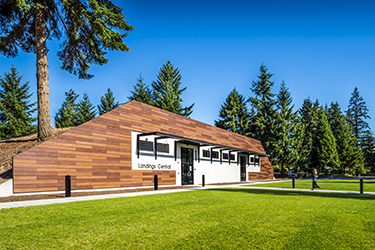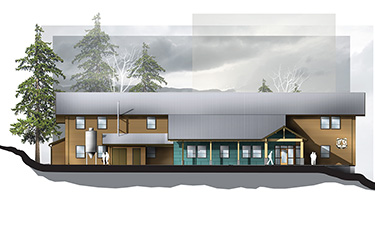|
Subscribe / Renew |
|
|
Contact Us |
|
| ► Subscribe to our Free Weekly Newsletter | |
| home | Welcome, sign in or click here to subscribe. | login |
Environment
| |
 |
March 24, 2016
Big-box store gets a second life after a green makeover
Rice Fergus Miller

Belding
|

Headrick
|
We often see empty, underutilized buildings throughout our communities. The dilapidated warehouse, an abandoned strip mall, empty stores — each of these tell stories of recession, the flight to the suburbs, changes in the way we shop, and finding our way with new technologies.
What if these existing buildings could be repurposed to help strengthen our communities instead of leaving a void? Rice Fergus Miller’s adaptive reuse work has focused on big-box, retail and warehouse renovations — to transform abandoned buildings into places where we work, gather as a community and, through strategic green building practices, become models of sustainability.
Adaptive reuse projects are innately sustainable — the greenest building is the one already standing.
Reused sites offer attractive benefits. They are centrally located, with ample parking and typically a strong existing shell and core that can be used and built upon. The infill of existing building stock can reduce urban sprawl and offer new ways to think about unstoppable growth and development, and acknowledge the heritage of the site.
From big-box to offices
Rice Fergus Miller worked with the King County Housing Authority to bring together previously separated KCHA departments into a central annex office facility in Tukwila.
This complete renovation of an existing 36,000-square-foot former big-box store promotes KCHA’s desire to create a cohesive environment and be a more integrated agency. The converted space provides work areas that are flexible, comfortable, efficient, high-ceilinged and filled with daylight.
With a budget of under $95 per square foot, Rice Fergus Miller and our mechanical engineer, Ecotope, created a design with an Energy Use Intensity of 26 — one-third the energy use of KCHA’s previous office buildings. The office space uses 50 percent less energy and 25 percent less water than their nearby executive office space.
Energy-efficiency features include new double low-e insulated glazing systems, energy recovery ventilation, variable refrigerant flow, zoned heat pump system, large skylights with internal light shelves, dimming lighting controls for corridors, and occupancy controls on all lights in rooms with doors.
This high-performing building received from ASHRAE a national second-place technology award for existing commercial buildings. The central annex office also received Energy Star certification from the federal government.
With a score of 98 of 100 for energy efficiency, KCHA has one of the most efficient office buildings in the nation.
Alaska warehouse conversion
Rice Fergus Miller has designed a combined administrative office for the Tongass National Forest and the Sitka Ranger District, currently under construction, in Sitka, Alaska.
The project involves renovation of an existing warehouse into office space, and adapting an existing shop building for storage.
The new office space will have radiant floor heating, heat-recovery ventilation and a projected EUI of 30.
Biomass, a Forest Service resource, is the primary heat source for this administrative building. With Southeast Alaska’s reliance on heating oil and their extremely limited supply of hydroelectricity, projects like this become a model for how towns like Sitka can grow without burdening the residents with additional infrastructure costs.
The two-story, 10,900-square-foot, wood-framed warehouse will become comfortable and efficient office space. The exteriors of the two structures are being designed to fit the context and character of historic Sitka, as well as the Forest Service’s Built Environment Image Guide.
The renovation of the exterior walls includes new siding, insulation, flashing, building wrap, doors and windows. The intent is to make the entire building weather tight.
New use for Navy bunker
Forest City Military Communities (now Hunt Cos.) is working to redevelop the Landings (formerly Jackson Park Navy housing), a former Navy ammunition depot during World War I and World War II, and renovate other military housing at the Bangor Naval Submarine Base in Kitsap County.
The project includes complete interior and exterior renovation of over 350 mid-1970s housing units and the repurposing of an ammunition bunker to become the new community center.
Rather than let the bunker continue to be an eyesore, Forest City and Rice Fergus Miller adapted an existing ammunition bunker into a community center. These bunkers (only three remain on the site) are the last vestige of the site’s war heritage. Instead of tearing them down, one was repurposed to recall history, reduce the carbon footprint of new construction, and take advantage of the construction to address Navy requirements for force protection.
The 5,000-square-foot bunker includes a multipurpose community room with a kitchen, fitness room with children’s play area, leasing office and presentation space. This renovated bunker helps retain the military heritage of the area.
Strategically placed windows help bring in daylight while meeting the requirements for blast-resistant construction. The mechanical system, coupled with new insulation strategies, help drive the building’s energy use down, resulting in greater efficiency.
This bunker-turned-community center anchors a redeveloped low-income naval housing community and brings a sense of place and identity it previously lacked.
These adaptive reuse buildings are comfortable, designed to last, and use materials and energy as efficiently as possible. Reuse is one way we can do the right thing for our community, our clients and our employees.
Greg Belding is an architect and principal at Rice Fergus Miller, where he focuses on high performing, energy-efficient projects. Elin Headrick is an associate and marketing director at Rice Fergus Miller.
Other Stories:
- ‘Passive house’ design can make housing more affordable
- Weyerhaeuser’s new headquarters will show off its wood products
- Developers who try to go green find money stands in their way
- Building operators add energy management to their repertoire
- Ballard fire station goes from energy hog to energy heaven
- South Lake Union’s ‘swale on Yale' is getting set to grow
- What is embodied carbon and why should we care?
- How sharing sit-stand desks will help Antioch be smaller and greener






